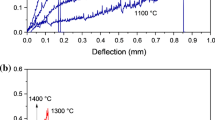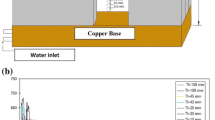Summary
-
1.
It has been established that strength vs porosity plots, which are in the form of curves at room temperature, also retain this character at low temperatures. At the same time, with decreasing temperature, the dependence of strength on porosity is more marked,
-
2.
The dependence of the ductility characteristics on porosity is described by curves at room temperature. With lowering temperature, this relationship is preserved. At the same time, the dependence of ductility on porosity is less pronounced for iron-nickel and bronze-graphite.
In the case of bronze, as temperature is lowered to 230°K, the rate of change of the ductility properties as a function of porosity increases. As temperature continues to fall, the relationships observed are the same as for iron-nickel and bronze-graphite.
-
3.
As temperature drops, the strength of the materials investigated rises by 120–180%. At low values of porosity, the dependence of strength on temperature is represented by curves. With increasing porosity, thier curvature decreases, and at high porosities the relationship is almost linear.
With decreasing temperature, the ductility characteristics vary differently for different materials. For bronze, as temperature drops to 230°K, the reduction of area increases, but decreases during subsequent temperature drop. With increase in porosity, a flattening of the maximum on the reduction of area vs temperature curves is observed,
A lowering of temperature adversely affects the ductility properties of iron-nickel and bronze-graphite, the deterioration being more marked at low porosity values. At high porosities, the change in the properties of these materials is approximately linear.
Similar content being viewed by others
Literature cited
I. M. Storozhevskii and V. N. Rudenko, Collection: High-Temperature Strength of Materials and Constructional Elements [in Russian] editor G. S. Pisarenko (Kiev, “Naukova Dumka” Press, 1965).
I. M. Storozhevskii and N. A. Filatova, Poroshkovaya Met.,5, 63 (1965).
I. M. Storozhevskii and N. A. Filatova, Poroshkovaya Met., (1965).
B. Ya. Pines and N. I. Sukhinin, Zh. Tekhn. Fiz.,26, 9, 2076 (1956).
B. Ya. Pines and N. I. Sukhinin, Collection: Investigations of Heat-Resisting Alloys [in Russian] (Moscow, Acad. Sci. USSR Press, 1958), V 3, pp. 326–338.
S. V. Serensen and O. Yu. Kramarenko, Collection: Spheroidal Graphite Cast Irons [in Russian] (Moscow, Mashgiz, 1954), pp. 207–225.
Author information
Authors and Affiliations
Additional information
Translated from Poroshkovaya Metallurgiya, No. 7 (43), pp. 69–72, July, 1966.
Rights and permissions
About this article
Cite this article
Storozhevskii, I.M., Filatova, N.A. Strength and ductility characteristics of sintered materials at low temperatures. Powder Metall Met Ceram 5, 570–572 (1966). https://doi.org/10.1007/BF00780119
Received:
Issue Date:
DOI: https://doi.org/10.1007/BF00780119




